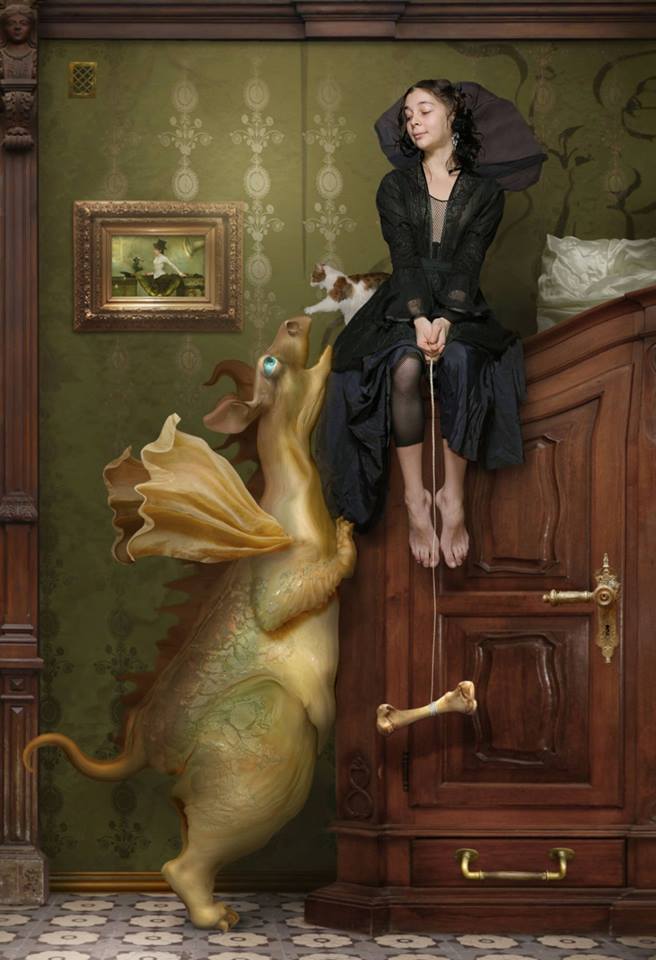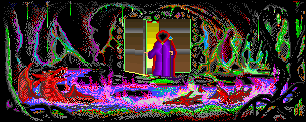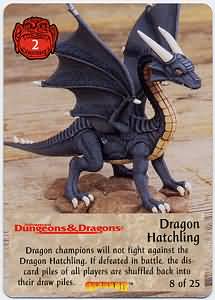

All right, so your party has obtained a
dragon egg. What are
they going to do with it? (Chorus: Sell
it in the city!)
Disposing of an egg in such a fashion
is a fine choice, especially if the city is only a day or two away. But
if travel time will be
a week or more, that egg just might hatch
enroute . . .
I. Chance of Hatching:
The chance of a dragon egg hatching
depends first on the age of the egg. This
is fairly easy to
determine:
Table I
| Die
roll |
Age of egg | Condition of eggshell | Base chance to hatch |
| 1 | Newly laid (1-2 wks) | Soft, rubbery | 0% |
| 2 | Young egg (3-5 wks) | Somewhat soft | 20% |
| 3 | Developing (6-8 wks) | Medium hard | 50% |
| 4 | Mature egg (9-10 wks) | Hard, leathery | 80% |
Of course, jostling an egg (such as during
travel) may affect
its date of hatching. To reflect this,
add a 5% chance per week
(cumulative) to the base chance of hatching
given in the above
table. Also add to the base chance a 10%
chance of hatching per
week (cumulative) due to aging which has
taken place since the
egg was encountered. For example, a developing
egg (6-8
weeks old, 50% base chance of hatching)
will have a 65% chance
of hatching after being transported for
one week (50% plus 10%
for additional aging plus 5% for being
transported), an 80%
chance of hatching after two weeks on
the road, and a 95%
chance after three weeks.
Hatching of the egg, once it is determined
that it is time for the
blessed event to occur, takes approximately
one hour. The egg
will begin to quiver, and as the emergence
of the dragon becomes more imminent, the egg will violently rock back and
forth
and from side to side. At the end of the
hour, the shell will
suddenly part, and out will tumble a baby
dragon. Note: any
dragon egg subjected to cold temperatures
(exception: White
Dragon
eggs) for longer than a few minutes, or kept in vacuum
or stasis (such as inside a Bag of Holding)
for any length of time
at all, will be destroyed, becoming hard
and shriveled up, and
the creature inside will die (with no
possibility of revival or
resurrection).

II. Size and appearance
of the newborn dragon: Dragons
hatching from relatively immature eggs
will tend to be smaller
than those hatching from more mature eggs.
Immature newborns also have a higher mortality rate:
Table 2
| Age of egg at hatching | Chance of survival | Size of baby dragon |
| 1-2 wks | 30% | Small |
| 3-5 wks | 70% | Small |
| 6-8 wks | 85% | Average |
| 9-10 wks | 99% | Huge |
Hit
dice of the baby dragon are calculated as in the Monster
Manual, starting as a very young
(1-5 years old) dragon. It will
“graduate” to a young dragon on its 6th
birthday, to a sub-adult
on its 16th birthday, and so on.
Dragons will, of course, be of the same
type (color) as their
parents.
III. Imprinting:
Newborn dragons, like most relatively
intelligent creatures, go through a period of “imprinting” shortly after
birth. The newborn dragon will become
very attached to the first
creature it sees after hatching. It will,
not knowing any better,
consider this creature to be “mother,”
and will follow its “mother” around to the best of its ability for its
entire first year of life.
The baby dragon will also attempt to copy
the actions of its
“mother” as closely as possible. Note:
It is just as likely for a
male character to be “mother” as it is
for a female character. It all
depends on whom the dragon saw first.
IV. Abilities of Baby
Dragons: During their first year, baby
dragons
must learn to use the various special abilities which
they may possess, such as speaking, magic
use, flight, and
breath weapon. The normal attack mode
of claw/claw/bite is
instinctive and does not need to be learned.
Speech: There is a bonus of 35%
to the chance of speaking
listed for the dragon
type in the Monster Manual if “mother” is
capable of speech. If a baby dragon is
capable of speech, it will
begin speaking after three weeks of life.
If the dragon does begin
to speak, there is a 20% chance of learning
a second language
(generally the racial tongue of “mother”).
Baby dragons will not
speak or understand any dragon language
unless it is taught to
them by “mother” (and they are of sufficient
intelligence to learn
it).
Magic use: This obviously applies
to speaking dragons only,
since dragons’ spells have no somatic
or material components.
There are certain bonuses (see Table 3)
to the chance of spell
use, depending on the character class
of “mother.”
Table 3
| Character class of mother* | Bonus to chance of spell use |
| Magic-User | 35% |
| Illusionist | 35% |
| Druid | 25% |
| Cleric | 20% |
| Spell-using Paladin | 15% |
| Spell-using Ranger | 15% |
* — If “mother” is a multi-classed character
falling into mare
than one category, only one bonus (the
highest of those which
apply) is gained.
If a dragon is capable of spell use, it
will be able to begin
attempting such action at 6 weeks of age.
The chance of successfully attempting a spell improves with practice:
Table 4
| Age of dragon | Chance of successfully attempting spell |
| 6-10 wks | 10% |
| 11-20 wks | 20% |
| 21-30 wks | 40% |
| 31-40 wks | 60% |
| 41-52 wks | 80% |
| Over 1 year | 100% |
Even if a spell is successfully cast, applicable
saving throws
may still prevent it from taking effect.
Note: A dragon’s possible
spells are rolled randomly, unless “mother”
is a Magic-User and
is attempting to teach certain spells
to the dragon. Spell use
remains as described in the Monster Manual.
Flight: All dragons
possess the capability of flight, but the skill
must be learned before the end of the
10th week of life. The
dragon must first be given the right idea.
One of the most
effective ways to do this is to jump up
and down, flapping one’s
arms. There is a 30% chance of the baby
dragon catching on to
the idea of flight (this chance should
be checked after each
attempt by “mother” to give the idea,
until the dragon is determined to have caught on).
Once the baby dragon learns that it can
fly, it must be encouraged to practice. Baby dragons will be reluctant
to practice (75%
chance of refusing to practice when encouraged
to do so; each
practice-session attempt must take place
no less than 6 hours
after the previous one, and only two such
attempts can be made
per day).
If a dragon does not practice flying 25
times before the end of
its 10th week of life, it will always
remain a “clumsy flyer.” Such
animals will fly only to remove themselves
from danger. They
may fly into walls (15% chance whenever
such an act is possible), cannot usually brake in mid-flight (25% chance
of doing
so), and cannot turn in flight (25% chance
of doing so). They
must rest for 4 hours after an hour of
flight, and are unable to
engage in normal activities (certainly
not fighting) during this
rest period.
In contrast, normal flyers (non-clumsy)
are only required to
rest for 1 hour after 20 hours of flight
(cumulative) and may
engage in all normal activities (but still
not including combat)
during the rest period. All dragons brought
up by other dragons
will be normal flyers.
Breath weapon: A dragon
gains the capability of using its
breath weapon at the age of 3 months.
Again, the dragon must
be given the idea. The method of achieving
this is up to the DM’s
discretion, and may prove to be the funniest
part of an adventure. The dragon has a 30% chance of getting the idea,
and
successfully using its breath weapon,
on each attempt made by
the teacher (“mother”). Such attempts
may be made once a
week by the teacher until a successful
discharge of the breath
weapon is accomplished.
Once a dragon has used its breath weapon,
it must remember
how to do the same thing on each subsequent
occasion (Table
5). Some dragons of more intelligent types
will have a better
chance of remembering (Table 6). There
is also a bonus of 1% to
the chance of remembering for each time
the dragon has previously been successful, as well as a 5% bonus on any
such
attempt if “mother” is trying to help
the dragon remember (by
coughing, sneezing, or another such method).
Table 5
| Age of dragon | Base chance of remembering breath weapon technique | Effect of weapon if successful |
| 3 months | 15% | 1/8 effect |
| 4-6 months | 40% | 1/4 effect |
| 7-9 months | 60% | 1/2 effect |
| 10-12 months | 80% | full effect |
| Over 1 year | 100% | full effect |
Table 6
| Race | Bonus |
| Black | -- |
| Blue | +05% |
| Brass | +05% |
| Bronze | +10% |
| Copper | +05% |
| Gold | +10% |
| Green | -- |
| Red | +10% |
| Silver | +10% |
| White | -05% |
Any dragon under 1 year of age will attempt
to use its breath
weapon in any situation which seems threatening
to them. Such
occasions would include loud noises, people
tripping, monsters
appearing (but not necessarily attacking),
and so forth. “Mother” is the only one who can curb this tendency in a
baby dragon.
After reaching 1 year of age, a dragon
will have discovered that
the use of its breath weapon should usually
be limited to really
dangerous situations, and needs no further
reminders of this
fact.
V. Care: Baby dragons
must be kept scrupulously clean or a
distinctive musky odor will linger in
the air around the dragon
and in its wake. This odor will not vanish
for 2 days, and enables
almost any creature with a nose to track
the dragon and those
who might be accompanying it. This odor
will also spook most
horses and mules (90% chance of such an
occurrence the first
time a particular scent is encountered).

A baby dragon
will eat voraciously for the first 6
months of its life. If “mother” does not
provide food, the baby
dragon will instinctively go hunting.
If restrained from hunting,
it will cry piteously with hunger and
otherwise attempt to lure
food to itself.
Food is not difficult to obtain since dragons
are omnivores
and can and will eat almost anything.
Dead monsters make fine
dragon food. In a wilderness area, dragons
will eat leaves and
branches from trees, uproot grass and
shrubs, and dig for truffles. (DM’s take note: This foraging may leave
a trail for others to
follow.)
VII. Behavior of Baby Dragons:

A dragon,
if well treated during its first year, will remain loyal to “mother” for
the rest of its
life. If “mother” dies, the dragon will
continue to follow the
member of the party most like the dragon
in alignment until it
reaches adulthood. If more than one character
fits this description, the one most similar to “mother” in abilities and
characteristics will be followed.
Upon reaching adulthood, a “domesticated”
dragon will go to
the wilds if “mother” is no longer alive.
There it will establish a
lair and otherwise act like a dragon of
its type.
If a dragon was not well treated during
its infancy, it will
attempt to slay “mother” during its second
year of life, and if
possible afterwards (whether or not the
attempt succeeds) it will
escape to the wilds. In any future encounters
with humanoids, it
will have an automatic -33% modifier on
its reaction roll. If more
than half of the humanoids in any given
encounter are of the
same race or abilities as “mother,” was,
the reaction roll will be
at a modifier of -50%.
When not under “mother’s” influence (which
means acting in
the same alignment behavior as “mother”),
a dragon will revert
to its instinctive alignment. This includes
looking for (and attempting to collect) treasure, as well as reactions
to any wandering passers-by. A chaotic evil dragon will attempt to slay
all beings within reach, lawful evil dragons will loudly criticize all
beings nearby, neutral and chaotic good
dragons will play harmless and sometimes seemingly purposeless practical
jokes, and
lawful good dragons will converse or play
with all beings who
seem friendly and of a similar alignment.
Top Image: Trust, by Robert Pritchard.
This is an 'epilogue' for Birth of the
Blues, the cover of Dragon 103.
Q. If a dragon is captured at a very young
age can it be tamed as a mount, and if
so will its alignment be the same as
the characters who trained it, or will
it stay the same as detailed in the rules?
A. Yes it is possible to capture and train
a dragon. This is a long and risky
business. To begin with dragons are
hard to subdue, and even harder to
keep subdued. There are rules in the
D&D Basic rulebook and AD&D
Monster Manual to cover this.
<Update: subdual is covered in UA>
Secondly, dragons take a long time to
mature, and a very young dragon can
take 20 years or more to reach
adulthood. We doubt that any PC
would have the time to
devote to a task like this.
Even if a dragon was successfully
captured & trained it would retain
the alignment of its birth.
(Imagine #5)